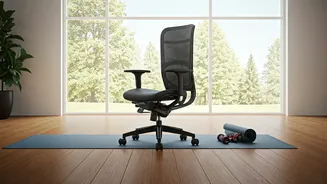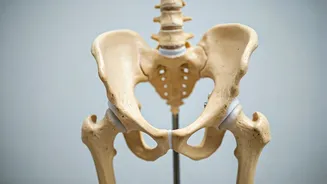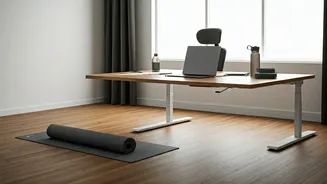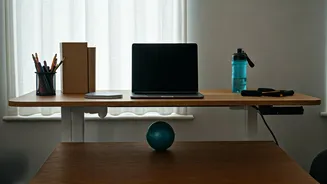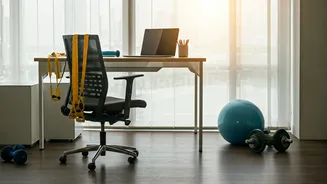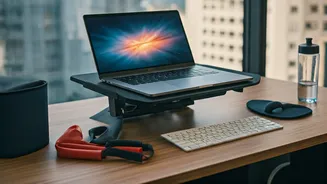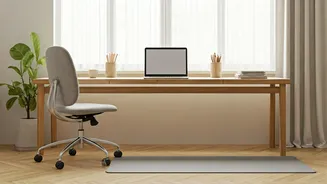Get Up, Move
The sedentary nature of desk jobs poses significant health risks, impacting everything from physical comfort to long-term well-being. Prolonged sitting
can lead to stiffness, reduced circulation, and an increased chance of developing chronic conditions. Regular movement is essential for countering these effects. Incorporating short bursts of activity throughout the workday can make a substantial difference. By taking breaks to stretch, walk, or do simple exercises, individuals can improve their posture, boost energy levels, and reduce the risk of health problems. It's about being proactive and conscious of the need to counteract the downsides of a sedentary lifestyle. The goal is to make movement a regular part of your daily routine to stay healthy and productive. This proactive approach supports both physical and mental well-being, enhancing the ability to manage the demands of a busy work life.
Hip Flexor Stretch
Hip flexors often tighten due to prolonged sitting, which can cause discomfort and limit mobility. Performing hip flexor stretches helps to counteract this tightness, promoting better posture and reducing lower back pain. To execute this stretch, one can start in a kneeling position with one leg forward, and gently lean forward until a stretch is felt in the front of the hip of the back leg. Holding this position for 20-30 seconds, and repeating on each side, can help to release tension and improve flexibility. Consistent practice of this stretch can lead to noticeable improvements in posture and a decrease in discomfort. The hip flexor stretch is a simple yet effective exercise to integrate into the workday to maintain comfort and prevent physical strain.
Glute Bridges
Weak gluteal muscles contribute to various problems, including poor posture and lower back pain. Glute bridges are an excellent exercise to strengthen these important muscles. To perform a glute bridge, lie on your back with your knees bent and feet flat on the floor. Lift your hips off the ground, squeezing your glutes at the top of the movement, and hold for a few seconds before lowering back down. Repeating this exercise 10-15 times can help build strength in the glutes, which will improve posture and reduce lower back pain. Regular glute bridges are an effective way to counteract the impact of extended sitting, promoting a stronger core and better body mechanics. They are easy to do and can be done without equipment, making them ideal for the office environment.
Hamstring Stretches
Tight hamstrings are a common result of prolonged sitting, contributing to back pain and limited mobility. Stretching the hamstrings regularly can alleviate this tightness. There are various ways to stretch the hamstrings, from standing toe touches to seated hamstring stretches. One can try sitting on the edge of your chair, extend one leg, and lean forward to reach your toes, holding this stretch for 20-30 seconds on each side. These stretches improve flexibility and reduce the risk of muscle strains. Consistent hamstring stretching helps maintain a balanced posture and improves overall physical well-being. It is a vital exercise for mitigating the adverse effects of a desk-bound lifestyle. By stretching the hamstrings, you enhance flexibility and reduce discomfort.
Shoulder Blade Squeezes
Rounded shoulders and poor posture are typical problems among people who work at desks. Shoulder blade squeezes can combat these issues by strengthening the upper back muscles and improving posture. To perform this exercise, sit upright, and squeeze your shoulder blades together as if trying to pinch a pencil between them. Hold this position for a few seconds, and then relax. Repeating the exercise 10-15 times strengthens the muscles that support good posture. Regular practice promotes better alignment and reduces strain on the neck and shoulders. Incorporating shoulder blade squeezes into your workday can have a noticeable effect on your posture and overall comfort, promoting better body mechanics and overall health.
Neck Tilts and Rolls
Neck stiffness and tension are common issues for those who spend a lot of time looking at screens. Neck tilts and rolls help alleviate this discomfort. Neck tilts involve gently tilting your head towards each shoulder, holding the stretch for a few seconds. Neck rolls involve slowly rotating your head in a circular motion, from one shoulder to the other and then to the chest. These exercises increase the range of motion in the neck and help to release tension. Doing these exercises several times throughout the day can prevent neck pain and headaches. Regular neck exercises are a simple yet effective way to maintain comfort and improve posture. The goal is to address the specific problems caused by desk work and make your workday more comfortable.
Wrist Exercises
Repetitive tasks such as typing can cause wrist strain. Simple wrist exercises can reduce the risk of injuries. These exercises may include wrist flexions, extensions, and rotations. Wrist flexions involve bending the wrist downwards, and extensions involve bending the wrist upwards, while rotations involve circling the wrist. Performing these exercises for a few minutes throughout the day keeps the wrist muscles flexible. Regular wrist exercises are crucial for people who spend long hours typing. By adding these exercises to the daily routine, one can diminish the risk of discomfort and maintain a healthy, active lifestyle.
